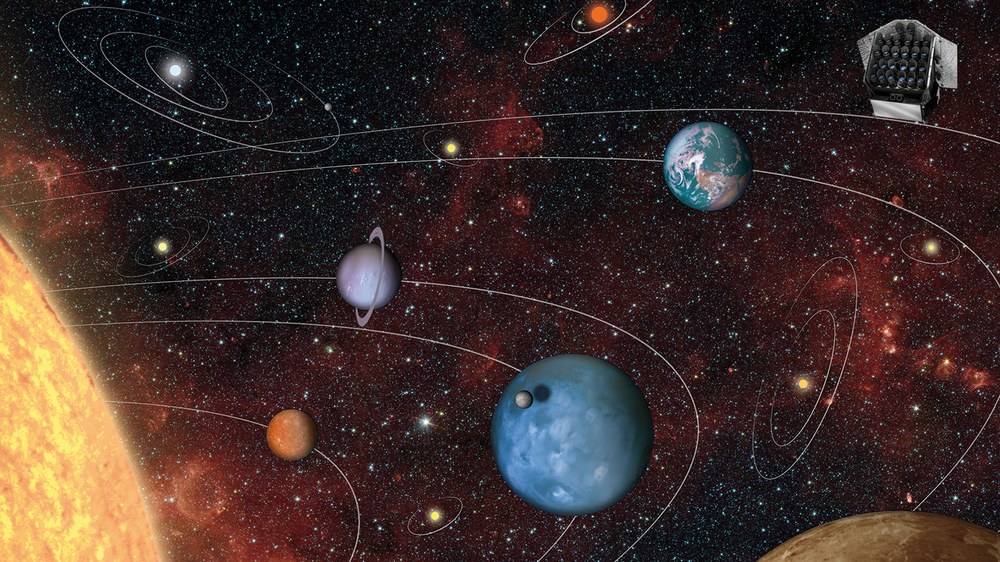PLATO – the space telescope searching for Earth-like planets in the Milky Way
The PLATO (PLAnetary Transits and Oscillations of Stars) space telescope is the third of five missions in the European Space Agency’s (ESA) ‘Cosmic Vision 2015–2025’ programme.
PLATO’s goal is to detect Earth-like planets in the Milky Way orbiting Sun-like stars – and even possessing conditions suitable for life. Instead of a single telescope with a large primary mirror and a detector in the focal plane, PLATO has 26 individual cameras, grouped together to capture a large field of view. Through 2025, the cameras are being installed on the spacecraft’s optical bench at OHB’s site in Oberpfaffenhofen.
The optical bench ensures that all cameras are pointing in a fixed direction, and in May 2025 engineers successfully installed and tested the first 24 ‘standard’ cameras. Over the coming months, two additional ‘fast’ cameras will also be installed. The German Aerospace Center (Deutsches Zentrum für Luft- und Raumfahrt; DLR), in particular its Institute of Space Research, is playing a key role in the development of these fast cameras, which are designed primarily to observe bright stars that would otherwise be overexposed during longer exposure times.
From its vantage point in space, PLATO’s 26 cameras will observe the Milky Way at a slight offset, together observing approximately five percent of the entire sky. During the course of the mission, more than 200,000 stars will be monitored.
DLR coordinates international collaboration
DLR is leading the international PLATO mission consortium and supports with both hardware and software, particularly in the calibration, operation and execution of readout electronics for the two fast cameras, the payload computer and elements of data processing on board the space telescope. DLR is also responsible for demonstrating and verifying the overall system performance throughout the various phases of the PLATO project and is significantly involved in the scientific analysis of the mission data.
In search of a 'second Earth'
PLATO is scheduled to launch in 2026 on board Europe’s new heavy-lift rocket, Ariane 6, from Kourou, French Guiana. Positioned 1.5 million kilometres from Earth, the telescope will examine several hundred thousand celestial bodies in the Milky Way for planets orbiting their star. One of the main scientific focuses will be the search for Earth-sized planets orbiting within the habitable zone of their stars – where water could exist in a liquid state. The mission will characterise these planets with remarkable precision, determining their radius, mass and age.
PLATO is expected to significantly enhance our understanding of the formation and evolution of celestial bodies and planetary systems – and may even reveal promising candidates for habitable worlds.
A new neighbour for the James Webb Space Telescope
After launch in 2026, Ariane 6’s upper stage will transport PLATO to Lagrange point 2 (L2), where NASA’s James Webb Space Telescope has been operating since Christmas Day 2021, delivered by an Ariane 5 rocket. From there, PLATO will orient its 26 cameras towards the outer edge of the Solar System and observe more than 200,000 stars during its planned four-year mission. Its cameras will search for regular fluctuations in the light intensity of stars, caused by a planet passing – transiting – in front of the solar disc. This ‘transit method’ allows astronomers to determine the size and orbit of the planet, and in some cases to analyse its atmosphere. It can also help provide insights into the star’s physical properties – all from the slightly but measurably dimmed starlight.
What is Lagrange point 2? |
|---|
Lagrange point 2, or L2 for short, is one of five points in space where the gravitational forces of Earth and the Sun balance each other out, allowing a satellite to remain in a stable position with minimal energy expenditure. Located 1.5 million kilometres from Earth, along a line extending from the Sun through Earth, L2 is especially useful for astronomy missions. From here, space telescopes like PLATO and James Webb can operate undisturbed by Earth’s radiation and with a permanent view into deep space, while maintaining uninterrupted communication with Earth. |
News
Mission PLATO – PLAnetary Transits and Oscillations of stars
- Duration: 1 January 2014 to 31 December 2035
- Leading institute: DLR Institute of Planetary Research (today DLR Institute of Space Research)
- Project type: Core funding
- Funding bodies: DLR Space Programme Directorate and German Space Agency at DLR
Participating DLR institutes and facilities
Related links
- ESA – PLATO mission
- Website of the PLATO payload consortium
- FH Aachen – University of Applied Sciences
- OHB EB (Contract ended)
- AIRBUS DS (Contract ended)



